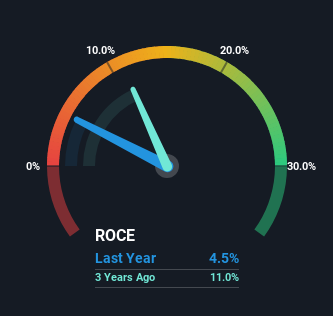Did you know there are some financial metrics that can provide clues of a potential multi-bagger? In a perfect world, we’d like to see a company investing more capital into its business and ideally the returns earned from that capital are also increasing. Ultimately, this demonstrates that it’s a business that is reinvesting profits at increasing rates of return. However, after briefly looking over the numbers, we don’t think Kitex Garments (NSE:KITEX) has the makings of a multi-bagger going forward, but let’s have a look at why that may be.
What Is Return On Capital Employed (ROCE)?
For those who don’t know, ROCE is a measure of a company’s yearly pre-tax profit (its return), relative to the capital employed in the business. To calculate this metric for Kitex Garments, this is the formula:
Return on Capital Employed = Earnings Before Interest and Tax (EBIT) ÷ (Total Assets – Current Liabilities)
0.045 = ₹798m ÷ (₹19b – ₹1.6b) (Based on the trailing twelve months to March 2024).
Thus, Kitex Garments has an ROCE of 4.5%. Ultimately, that’s a low return and it under-performs the Luxury industry average of 11%.
Check out our latest analysis for Kitex Garments

Historical performance is a great place to start when researching a stock so above you can see the gauge for Kitex Garments’ ROCE against it’s prior returns. If you want to delve into the historical earnings , check out these free graphs detailing revenue and cash flow performance of Kitex Garments.
How Are Returns Trending?
In terms of Kitex Garments’ historical ROCE movements, the trend isn’t fantastic. To be more specific, ROCE has fallen from 20% over the last five years. Although, given both revenue and the amount of assets employed in the business have increased, it could suggest the company is investing in growth, and the extra capital has led to a short-term reduction in ROCE. If these investments prove successful, this can bode very well for long term stock performance.
On a related note, Kitex Garments has decreased its current liabilities to 8.4% of total assets. So we could link some of this to the decrease in ROCE. What’s more, this can reduce some aspects of risk to the business because now the company’s suppliers or short-term creditors are funding less of its operations. Since the business is basically funding more of its operations with it’s own money, you could argue this has made the business less efficient at generating ROCE.
The Key Takeaway
While returns have fallen for Kitex Garments in recent times, we’re encouraged to see that sales are growing and that the business is reinvesting in its operations. And the stock has done incredibly well with a 213% return over the last five years, so long term investors are no doubt ecstatic with that result. So while investors seem to be recognizing these promising trends, we would look further into this stock to make sure the other metrics justify the positive view.
One final note, you should learn about the 4 warning signs we’ve spotted with Kitex Garments (including 3 which are significant) .
If you want to search for solid companies with great earnings, check out this free list of companies with good balance sheets and impressive returns on equity.
Valuation is complex, but we’re here to simplify it.
Discover if Kitex Garments might be undervalued or overvalued with our detailed analysis, featuring fair value estimates, potential risks, dividends, insider trades, and its financial condition.
Have feedback on this article? Concerned about the content? Get in touch with us directly. Alternatively, email editorial-team (at) simplywallst.com.
This article by Simply Wall St is general in nature. We provide commentary based on historical data and analyst forecasts only using an unbiased methodology and our articles are not intended to be financial advice. It does not constitute a recommendation to buy or sell any stock, and does not take account of your objectives, or your financial situation. We aim to bring you long-term focused analysis driven by fundamental data. Note that our analysis may not factor in the latest price-sensitive company announcements or qualitative material. Simply Wall St has no position in any stocks mentioned.





